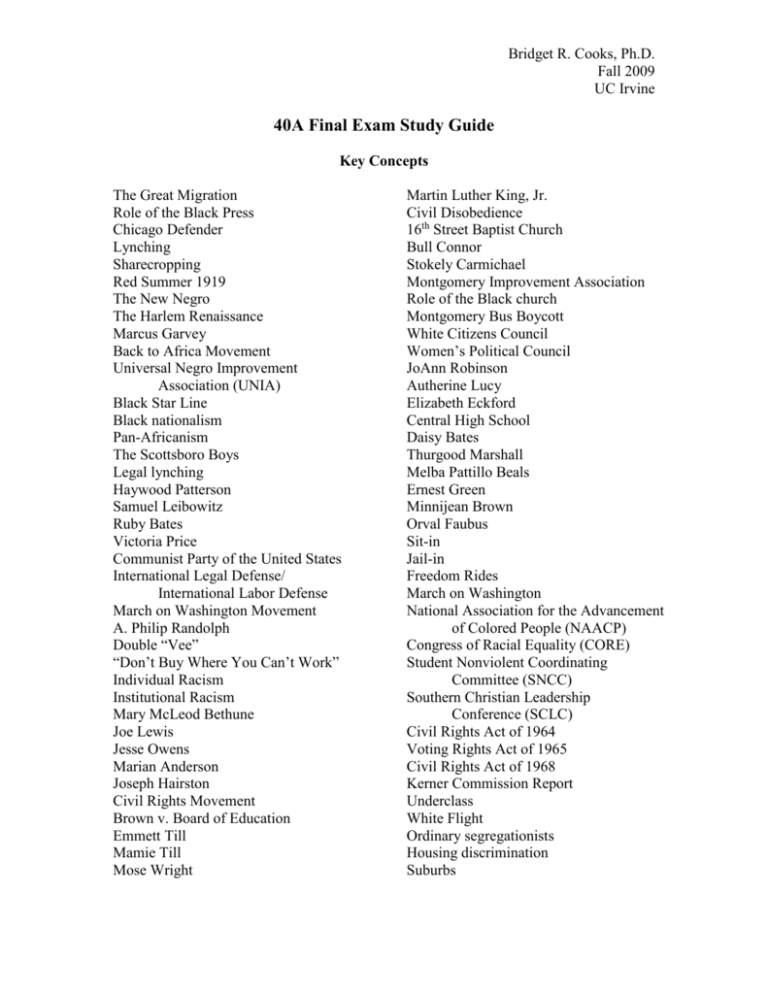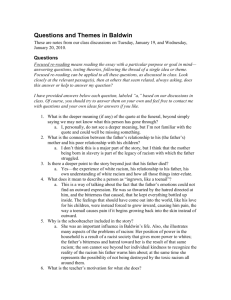AAS40A Final Study Guide - UC Irvine, OpenCourseWare
advertisement

Bridget R. Cooks, Ph.D. Fall 2009 UC Irvine 40A Final Exam Study Guide Key Concepts The Great Migration Role of the Black Press Chicago Defender Lynching Sharecropping Red Summer 1919 The New Negro The Harlem Renaissance Marcus Garvey Back to Africa Movement Universal Negro Improvement Association (UNIA) Black Star Line Black nationalism Pan-Africanism The Scottsboro Boys Legal lynching Haywood Patterson Samuel Leibowitz Ruby Bates Victoria Price Communist Party of the United States International Legal Defense/ International Labor Defense March on Washington Movement A. Philip Randolph Double “Vee” “Don’t Buy Where You Can’t Work” Individual Racism Institutional Racism Mary McLeod Bethune Joe Lewis Jesse Owens Marian Anderson Joseph Hairston Civil Rights Movement Brown v. Board of Education Emmett Till Mamie Till Mose Wright Martin Luther King, Jr. Civil Disobedience 16th Street Baptist Church Bull Connor Stokely Carmichael Montgomery Improvement Association Role of the Black church Montgomery Bus Boycott White Citizens Council Women’s Political Council JoAnn Robinson Autherine Lucy Elizabeth Eckford Central High School Daisy Bates Thurgood Marshall Melba Pattillo Beals Ernest Green Minnijean Brown Orval Faubus Sit-in Jail-in Freedom Rides March on Washington National Association for the Advancement of Colored People (NAACP) Congress of Racial Equality (CORE) Student Nonviolent Coordinating Committee (SNCC) Southern Christian Leadership Conference (SCLC) Civil Rights Act of 1964 Voting Rights Act of 1965 Civil Rights Act of 1968 Kerner Commission Report Underclass White Flight Ordinary segregationists Housing discrimination Suburbs Bridget R. Cooks, Ph.D. Fall 2009 UC Irvine Essays 1. What was the renaissance in the Harlem Renaissance? 2. Clearly identify each part of your essay with the appropriate letter A-D. A) What was The Great Migration? B) Discuss three challenges African Americans faced after they reached the North. C) Provide three arguments for why The Great Migration was a success. D) Discuss three factors that contributed to the exceptional violence in the summer of 1919. 3. What was the Universal Negro Improvement Association (UNIA)? According to course readings, what are two significant criticisms and two praiseworthy contributions of the association? 4. Discuss two arguments for and two arguments against integration by two of these Black leaders in the first half of the twentieth century: Marcus Garvey, William Pickens, W.E.B. DuBois, and Francis J. Grimké. 5. A) According to Scottsboro: An American Tragedy (Dir: Barak Goodman, 2001) why did Samuel Leibowitz fail to appeal to the white southern jury? B) How did the jury perceive Victoria Price and her testimony? C) Why did the jury discount Ruby Bates testimony? Clearly identify each part of your essay with the appropriate letters A-C. 6. According to Stokely Carmichael and Charles V. Hamilton what are the definitions of institutional racism and individual racism? What are the differences between them? Give an example of each from course texts discussed since the midterm (you may choose from essays and films). Do not give the examples from the definition by Carmichael and Hamilton. 7. According to Richard M. Dalfiume, what impact did the March on Washington Movement have on the modern Civil Rights Movement? 8. A) Discuss three significant events between 1942 and 1957 that led to the Civil Rights Movement? B) Why were these events significant? C) What were the social and political repercussions of these events? Clearly identify each part of your essay with the appropriate letters A- C. 9. Discuss two strategies that helped to make the Montgomery Bus Boycott a success. Be specific. Why were each of these strategies successful? 10. A) Identify and discuss the courageous decision that Mamie Till made to insure that her son did not die in vain. B) What particular strategy did she set for other Civil Rights activists that followed her? C) Why was it effective? Clearly identify each part of your essay with the appropriate letters A- C. Bridget R. Cooks, Ph.D. Fall 2009 UC Irvine 11. A) What were some strategies devised by the Black community in Little Rock to improve their conditions within a predominantly White supremacist context? B) How do the experiences of African Americans in Little Rock during this event illustrate the difference between de jure and de facto equality? Clearly identify each part of your essay with the appropriate letters A- B. 12. A) How was the response of most Whites to school integration in Little Rock similar to White responses to conditions and ideas in the South during Reconstruction? B) Which side of the political battle was initially supported with money and military force, and why? C) What was the aftermath for Governor Faubus’ career? Be sure to address both Southern Whites and the role of the federal government in your essay. Clearly identify each part of your essay with the appropriate letters A- C. 13. A) According to Nikhil Pal Singh, what are the dual perceptions of Martin Luther King, Jr. as a Civil Rights leader? B) Which of these perceptions did the majority of Americans adhere to? C) What are the consequences to race relations that Singh identifies as resulting from this view? Clearly identify each part of your essay with the appropriate letters A- C. 14. A) According to the Kerner Commission Report and its analysis by John Boger, what factors combined to create a recipe for rioting in 1967? Discuss at least one example from each of the four aspects of life addressed by the Commission. B) Which of the Commission’s recommendations were followed to prevent rioting from happening in the future? C) What has been the impact of the recommendations? 15. What acts of individual and institutional racism did Joseph Hairston experience? What does his experience tell us about African American servicemen serving in WWII? 16. According to Manning Marable, how and why was the 1963 March on Washington made more moderate in its political platform?








